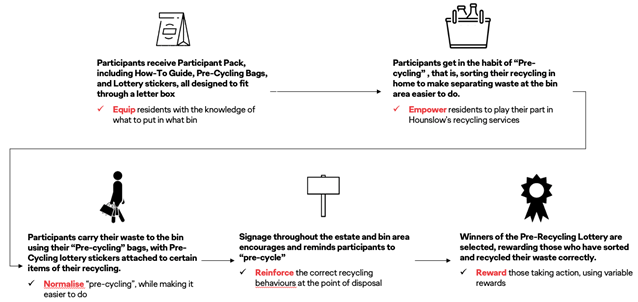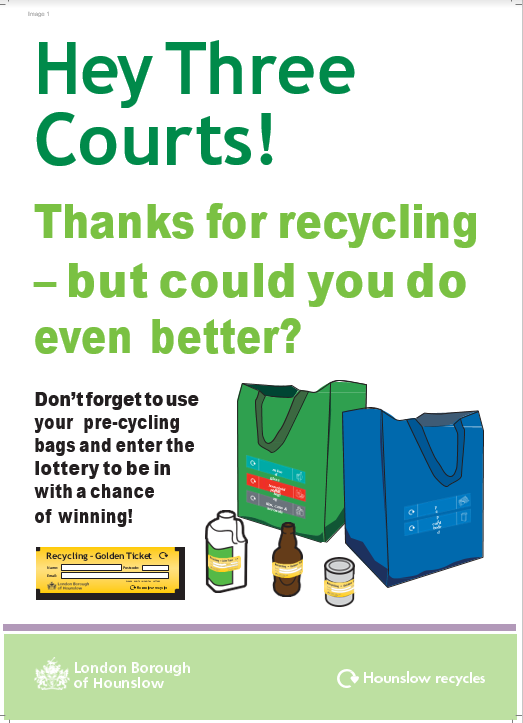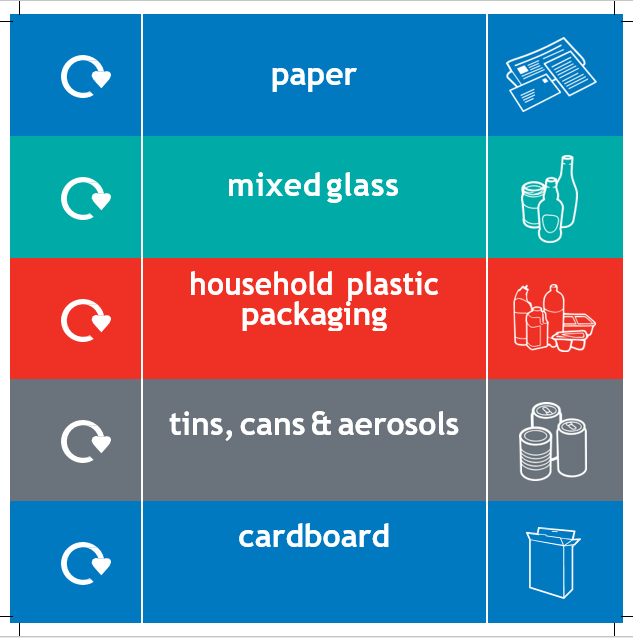From August 2019 – May 2021, the London Borough of Hounslow and Ogilvy Consulting’s Behavioural Science Practice collaborated on a rigorous behavioural insights trial to effectively test ways to increase recycling in high-rise properties.
Introduction
An end-to-end “Pre-Cycling” solution was designed to encourage residents not only to recycle correctly, but also to develop systems for collecting and sorting their recycling at home. Due to the unforeseen COVID-19 pandemic the planned Randomised Control Trial (RCT) was not carried out as expected, however preliminary findings and lessons learnt are detailed in this report for the reference of future researchers and practitioners alike.
The challenge
Across the London Borough of Hounslow, 39 per cent of housing stock are high-rise flats (or those with communal waste and recycling facilities). However, just 5.9 per cent of the borough’s recycling currently comes from these properties. With around 40,000 flats across the borough, high-rise properties therefore represent a significant untapped potential in efforts to increase borough-wide and London-wide recycling rates.
To encourage Hounslow residents living in high-rise flats with a shared bin area to recycle more, we were tasked to design interventions that helped residents to:
- Put the right thing in the right bin
- Store or prepare recycling in the home
In driving these behaviours, we aimed to achieve:
- An increased amount of recycling waste which is put in the recycling bins.
- A decreased amount of recycling waste which is put in the residual waste bins.
- A decreased amount of residual waste which is put in the recycling bins.
- Improved resident attitudes and perceptions of recycling and waste provisioning.
In order to do this, we would need to create innovative and practical solutions embedded with Behavioural Science, specifically designed to overcome the behavioural and psychological barriers which currently prevent residents from recycling correctly.
The process
Because behaviour is heavily influenced by the context in which it occurs, we first conducted an environmental audit of a number of high-rise flats within Hounslow, observing how people behave and reviewing the existing waste facilities. We also conducted 13 in-depth qualitative interviews with residents, in order to build a strong understanding of the environment in which residents make their recycling decisions.
These interviews were semi-structured in nature to allow for the exploration of emergent themes and ideas. Participants were from the estates which were selected for the trial (see ‘Planned Trial Methodology’), recruited with help from the relevant housing associations. Attention was paid to ensure that the respondents come from a range of socioeconomic backgrounds, household makeups, tenure length ages, and employment statuses.
Topics explored included: attitudes toward their neighbourhood and estate; weekly routines; recycling habits; accessibility of existing recycling facilities; waste management processes; and perceived recycling efficacy. The exact areas of focus were outlined in a topic guide, informed by additional desk research, and with input from Hounslow Council.
Finally, we also conducted a Behavioural Insights Review in which we interrogated the academic literature to uncover further insights into what motivates – or discourages – correct recycling behaviour, especially in high rise properties.
The seven key psychological and behavioural challenges that we identified were:
- Diffusion of responsibility – Residents unanimously shared a belief that “someone else would take care of it” if they chose not to recycle or recycled incorrectly.
- Distrust in the process – Limited understanding of the recycling process and a general distrust that their recycling would actually go on to be recycled correctly.
- Lack of time & convenience – Perception that recycling is too time intensive and cumbersome.
- No consistent in-home storage – Storage systems for recycling were either inconsistent or lacking altogether in people’s properties. This further exacerbated the belief that recycling is too cumbersome (and that throwing everything in the general waste bin is much easier).
- Lack of feedback – Residents received no feedback on what happens to their recycling, the positive consequences of recycling, or the negative consequences of contamination.
- Drop in the ocean effect – Related to the lack of feedback, there was a lack of belief that individual actions actually make a difference.
- Perception of social norms – Misperceptions about how much other people recycle and an assumption that ‘most people do the same as me’.
Based on these findings we then ran a full-day workshop with members of the council and waste management staff. In this session we used behavioural frameworks and ideation techniques to develop interventions that could not only successfully overcome these barriers, but that could also be replicated and scaled up across the borough. The top three intervention ideas were identified to take forwards into the trial.
The solution
To overcome the identified barriers and encourage Hounslow residents in our trial to recycle correctly, we developed three interventions which were grouped within a ‘Participant pack’ that was delivered to residents. The interventions within this were:
- ‘Welcome to the Pre-cycling programme’ how-to guide
- Pre-cycling bags
- Pre-cycling lottery
'Welcome to the pre-cycling programme' how-to guide:
A how-to guide in the form of an engaging leaflet which welcomes and introduces residents to “pre-cycling” – the idea of sorting recycling in-home, then recycling correctly. This was designed to equip residents with the knowledge of what to put in what bin; empower residents to play their part in Hounslow’s recycling services; and explain to residents the pre-cycling bags and pre-cycling lottery.
This included:
- Specific, actionable advice on what can – and importantly, what cannot – be recycled in each waste stream.
- An engaging visual flow chart which situates the resident’s actions within the wider journey of a recyclable item, showing the journey and process from end-to-end. This effectively communicates that residents’ behaviour is key – without them, the borough is unable to carry out recycling services effectively – and that their recycling does indeed go on to be recycled, in order to increase trust in the recycling process.
- Explanation of why correct recycling behaviour is so important and why it’s crucial to avoid contamination.
- Example outcomes – fun facts explaining the positive benefits of recycling, in a clear and concrete way. These were in the style of ‘every little helps’ to show that individual behaviours do have an impact and to increase the sense of personal responsibility amongst residents.
- Thanking residents for pre-cycling, to reinforce their positive recycling behaviours and call out the efforts that residents are already making.
- Chunked information, simplified text and graphics to make it as easy to read and understand as possible.
Pre-cycling bags:
Residents were provided with two ‘pre-cycling’ bags, to help them to sort and store their recycling in-home. Residents were also provided with stickers that enabled them to label each bag with the recycling streams they were storing in each one.
These bags were designed to meet a number of objectives:
- To normalise ‘pre-cycling’ (the sorting of recycling at home). The simple fact of having a bag or bin in your kitchen specifically for recycling would naturally encourage people to recycle more and make sorting and recycling a default behaviour.
- To make the trip to the recycling bin easier each time, as the recycling has been sorted or partially sorted already in your home.
- To build the visual social norm of in-home recycling as the ‘done thing’, as residents “wear” the bags around the estate to carry their waste to the bin sites.
Pre-cycling lottery:
Residents were able to win a prize by recycling correctly through the ‘pre-recycling lottery’, a lottery you enter by recycling! Residents were given a number of ‘golden stickers’, which they could write their contact details on and stick onto items in their recycling. Staff at the materials handling facility would then pick out all golden ticket items that they find, and lucky winners would be selected at random. As long as the recycling item was in the correct recycling stream, the resident would be contacted to claim their prize.
The lottery was designed to meet a number of objectives:
- To reward those taking action. By providing a clear positive reward, we hoped to encourage take-up and use of the pre-cycling bags, and improve engagement with recycling more generally.
- To motivate people through the use of ‘variable rewards’ (i.e. a lottery), as these have previously been demonstrated to be an effective lever to pull when aiming to change behaviour.
In addition, posters were put up around the bin areas in each estate, which thanked residents for recycling correctly (“Thanks for recycling”), called out the pre-cycling bags (“Don’t forget to use your pre-cycling bags”) and emphasised the pre-cycling lottery (“Enter the lottery to be in with a chance of winning”). These helped to reinforce correct recycling behaviours at the point and place of disposal.
The overall journey:
Image 1
The impact
Planned trial methodology
To capture the impact of our intervention, a Randomised Control Trial (RCT) was planned across ‘nudge-ready’ estates in the borough, where ‘nudge-ready’ refers to properties which have an acceptable provisioning of waste and recycling bins already in place.
Nine estates (1,087 households) were randomly assigned to the treatment condition; these residents received the intervention. A different selection of nine estates (925) was allocated to the control group, which received no intervention. Care was taken to control for the relative size (number of flats), structure (courtyards, stairwells, etc), demographic factors (socioeconomic status) and the management type of participating estates. A bin fill survey and waste composition analysis were carried out by Hounslow Council and Recycle 360 to establish baseline measurements for both groups for the following variables:
- amount of recycling waste (kg/hh/ww)
- amount of residual waste (kg/hh/ww)
- amount of residual waste in the recycling bins (kg/hh/ww)
- amount of recycling waste in the residual waste bins (kg/hh/ww)
Additionally, residents of the estates in the treatment condition received a qualitative survey after the trial period to capture their experience of the intervention.
Limitations
The randomised control trial described coincided with the first and second waves of the COVID-19 pandemic, complicating the distribution of Participant Packs and the collection of associated data.
The following limitations impacted the team’s ability to collect results for the bin fill survey, which aimed to capture volume of waste disposed of by participating estates:
- Resource - The planned approach to measuring the outcome variables of interest with a small dedicated team proved to be untenable in light of the increased demand for waste management services during the COVID-19 lock-down.
- Subjective measurement tools – As a secondary approach, collection crews were tasked with recording bin fill before emptying containers, estimating fill level at 0/25/50/75/100%. Bin fill estimation is subjective and using multiple employees increased the potential for inconsistency, although the assessment instructions were simple and well understood and the ratio level easily determined in quarter bin increments.
- Increased volume of waste: On many sites, both recycling containers and residual waste containers were assessed as 100 per cent full at each visit, meaning any channel shift would be less easily recognisable, or potentially, that residents wishing to put out more recycling were unable to do so.
Due to capacity constraints, only four estates participated in the waste composition analysis, which looked to understand contamination rates of participants’ recycling.
Material was collected on the day of scheduled collection, or on the day before, with bins being replaced at each site. The full bins were returned to the Southall Lane depot, where each pair of sites’ material was tipped on the floor, mixed with a front loading shovel and then separated into two piles. A coin toss was made to chose one of the piles, which was subsequently divided into two further piles. A further coin toss was made to choose a pile from which an appropriate sample of material was taken. Each sample of material was separately sorted into target and non-target materials, and weights of each material were assessed using Recycle 360’s calibrated Adams industrial scales used routinely for recycling material sampling, by a trained operative. Samples were taken before and after the interventions.
There were a number of limitations with the waste composition analysis, including the fact that the analysis period coincided with the second lockdown in the UK, and changes in staff meant that the analysis was not carried out in the desired way. A closer group of sites geographically may have helped.
Results
While some changes were anecdotally indicated at two specific sites for the bin fill survey, the results were unsuitable for statistical analysis and thus haven’t been included here.
The resulting findings from the waste composition analysis are as follows:
| Targets | Card | Glass | Paper | Plastic |
|---|---|---|---|---|
| Before | 67.65% | 93.72% | 94.9% | 73.15% |
| After | 78.23% | 98.84% | 96.72% | 66.48% |
| Change | 10.57% | 5.12% | 2.22% | -6.67% |
| Targets | Card | Glass | Paper | Plastic |
|---|---|---|---|---|
| Before | 87.78% | 94.24% | 94.15% | 43.40% |
| After | 61.49% | 97.01% | 97.20% | 39.34% |
| Change | -26.28% | 2.77% | 3.04% | -4.07% |
The first pair of sites appears to show an improvement following the intervention, while the second pair of sites does not. These results are not statistically significant.
A survey was created to better understand the impact of the interventions for residents. The council worked with Ogilvy to develop a short questionnaire for feedback on the precycling bags, posters, leaflet, and golden tickets. The questions were quantitative: simple, multiple choice and used a 5-point semantic differential scale and qualitative: with more open-ended questions around what could have been improved and what they liked about the interventions. We had intended for the managing agents of the sites to send out the survey on our behalf, they would have more specific data about the property’s occupants with names and personal email addresses which we hoped would yield better participation. We also felt that residents may be more inclined to respond to their managing agent, believing the request is more important than a request from the council. Unfortunately, we were unable to engage with any managing agents and therefore distribution of the survey sat with the council.
To try and reach as many residents as possible several posters with a QR code that linked to the survey were put up in each of the sites bin rooms. Included on the poster was that several respondents would be chosen at random to win a £10 voucher - we hoped this positive reward would encourage participation in the survey. The survey was open for two weeks. Disappointedly, we did not receive any response to the survey across all sites. This consequently meant that we were unable to gain further insight into the success of the interventions from residents' perspectives.
Lessons learnt
As the first behavioural insights trial undertaken in Hounslow, it was important to involve colleagues from across waste management services firstly to gain buy-in for the project itself, but also learn different perspectives and insights for our audience. Staff input in the ideation workshops was crucial to generate relevant, effective ideas.
It was also imperative that the ideas we generated could also be adapted across other boroughs to ensure they offered as much value as possible.
Colleagues across the council – especially within the central research team and in the services - have now gained skills in developing behaviourally informed communications and the Hounslow team is looking to build upon this to ensure this approach spreads across the council as a whole.
Reflecting on the methodology of the trial, there were also learnings that would benefit future research undertaken by local authorities in this space:
- Ensure there are sufficient sampling occasions – to support a conclusion that change did occur and that it was a result of the interventions.
- Allocate additional project management support – creating detailed templates for team members collecting data and designating specific employee(s) dedicated to the task over time would help to ensure consistent results. Where that employee is temporarily unavailable, samples could be taken and set aside for future analysis on their return.
- Incentives for individuals involved should be considered – to secure commitment to the survey from staff with conflicting work tasks. This would be more effective than employing a dedicated resource for such ad-hoc activity.
- Use ward officers to monitor the sites included in the study – to see how the bins are being used and to ensure that the sites are looking their best to encourage use. Ward officers could also be used to assist with the waste composition analysis, by visiting the depot during the pre and post intervention to check on quality and quantity.
- Consideration should be given to aligning collection days on any site – so that all bins types are emptied on the same day. With collection days varying at each location, resident behaviour may be influenced by the availability of specific waste containment volume. E.g. close to, but prior to refuse collection, residents may be more tempted to dispose of waste in recycling if refuse bins are perceived to be full or overflowing. This may impact either volume or compositional surveys.
- Provide ample time for creating the recycling bags – the pre-cycling bags were not able to be produced as intended, due to time delays and restrictions on the manufacturer’s side (due to COVID-19). Ideally, we would have produced bags which were able to stand upright, which had a compartment down the middle to split each bag into two sections, and which came with graphics and wording printed on the outside to indicate what should be stored in each section. In future we would ensure that the manufacturers can deliver bags to these specifications, as they are design features that would make the bags more useful and useable by residents. Existing research indicates that providing bags for in-home recycling can be an effective way of increasing recycling rates, especially when combined with other interventions.
- Include weekly communications designed to build on the intervention – it would have been helpful to include weekly communications to residents which prompted further action, with encouraging messages like ‘how are you getting on?, ‘are you using your bags?’, and ‘have you entered the golden ticket competition?’ A drip feed of the same message may see the desired outcome. If this was a borough-wide initiative, it would also be possible to use other communications channels (e.g. social media) to publicise the intervention – particularly the lottery – which would likely increase both awareness and impact of the intervention.
Contact
Cindy Gardener ([email protected])
Jordan Buck ([email protected])
Kimberly Richter ([email protected])
Resources
Image 2
Image 3
Image 4




